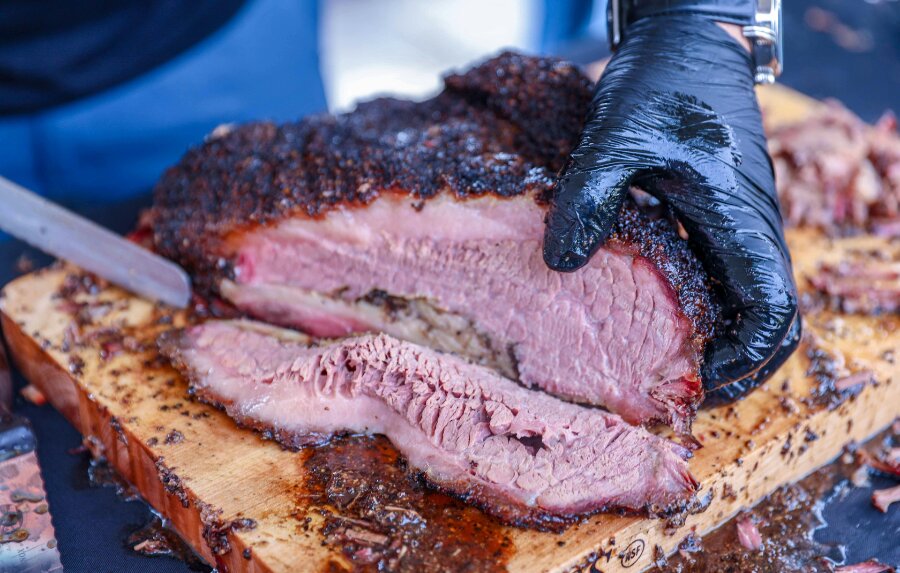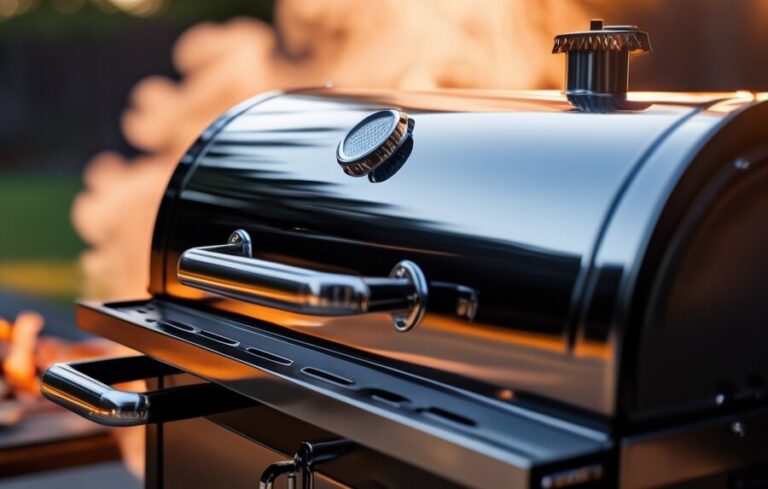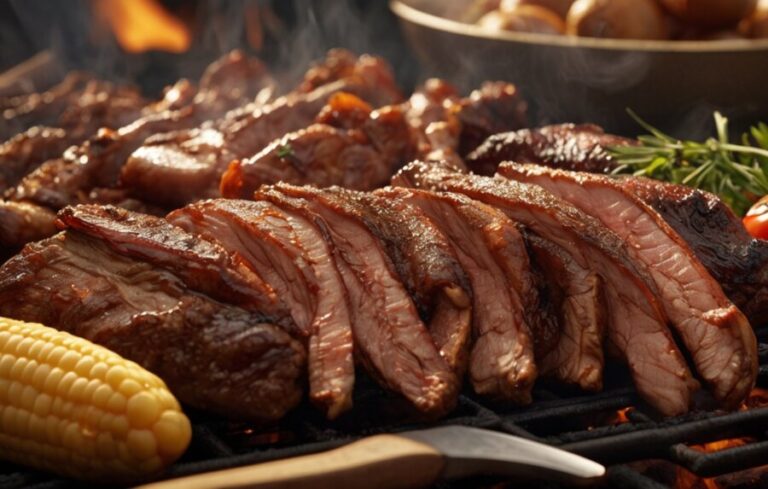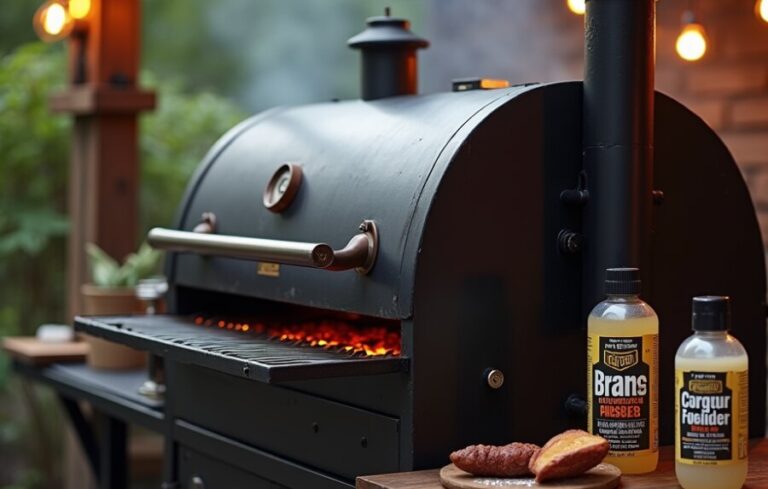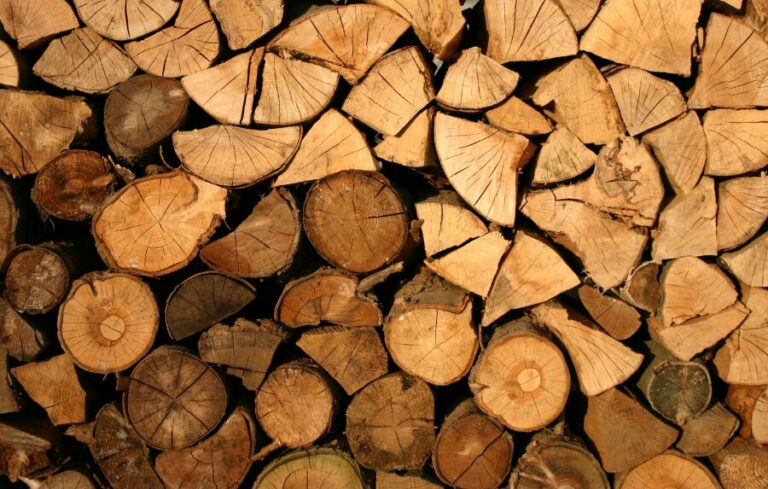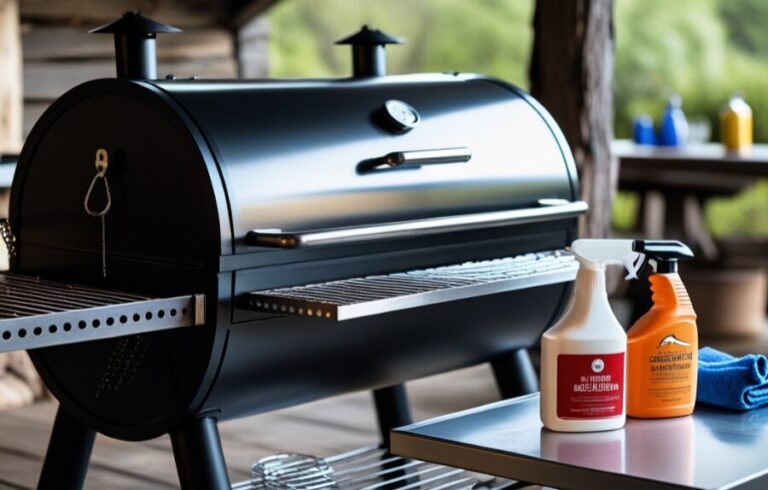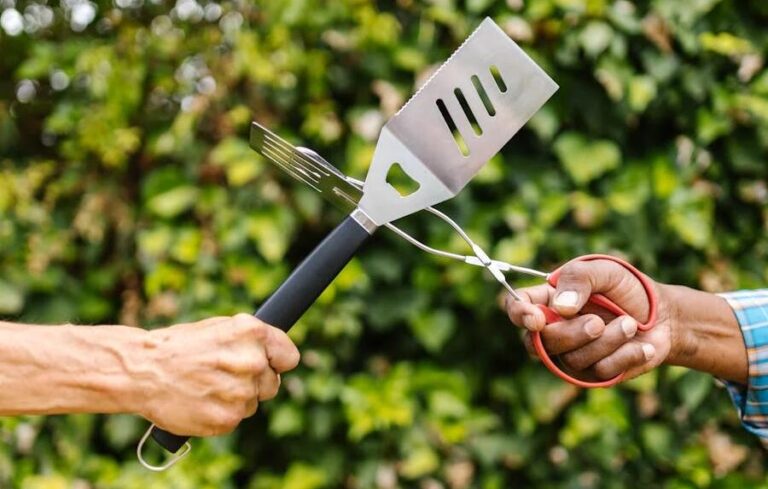Our evaluations and product assessments are conducted using a thorough and unbiased approach. Should you choose to buy any items through our provided links, we might receive a commission Read our disclosures.
Mastering BBQ Smoking Techniques
Getting good at BBQ smoking is one of those skills that turn backyard cooking into a flavorful art form. I’ll break it down, focusing on mastering air flow and keeping the temperature just right. These two things make the difference between “meh” and “wow” when it comes to smoked meat.
Cracking the Code of Smoker Air Flow
Air flow is your secret weapon for controlling the heat in your grill or smoker, especially if you’re using charcoal or wood. The intake and outtake vents are your key players here.
| Vent Type | Function |
|---|---|
| Intake Vent | Feeds oxygen to the fire, ups the heat |
| Outtake Vent | Lets out smoke and gases |
First, keep that outtake vent wide open to let the smoke escape. Then, tweak the intake vent to dial in your target heat. If your smoker’s acting up, always check for leaks. Extra air sneaking in can mess with your temperature control, making things frustrating. For more tips, check out BBQ Smoking Temperature Control.
Vertical smokers are usually easier to manage, but offset smokers and grills? A bit more tricky. Their design and lack of insulation can make stable temperature a challenge.
Mastering Temperature Regulation
Getting the temperature just right is the holy grail of BBQ smoking. Start by firing up your smoker, aiming for a sweet spot between 225°F and 250°F. Here’s a quick guide for different meats:
| Meat Type | Ideal Smoking Temperature (°F) |
|---|---|
| Turkey | 165 |
| Pork Shoulder | 195 – 205 |
| Brisket | 195 – 205 |
| Chicken | 165 |
Mostly, you’ll fiddle with the intake vent. The outtake vent stays open to let out all that flavorful smoke. Knowing your smoker’s quirks and how airflow impacts it can absolutely transform your BBQ game.
Mastering these techniques ensures every BBQ session is a hit. Dive into more tips with our guides on Essential BBQ Smoking Tools and Top BBQ Smoking Tips. Happy smoking!
Smoking Times and Temperatures
BBQ smoking isn’t just a hobby—it’s an art form. But before you crank up your smoker, let’s make sure you’ve got your times and temps nailed down. Here’s the skinny on smoking turkey and pork, so your next cookout isn’t just good—it’s legendary.
Turkey Smoking Guidelines
Smoking a turkey is like a ticket to flavor town. Follow these pointers to get that perfect, juicy bird:
- Cooking Temperature: Keep that smoker humming at 225°F – 250°F.
- Internal Temperatures:
- Whole turkey breasts: 165°F
- Turkey thighs: 175°F
- Cooking Time Estimate: Roughly 1.5 hours per pound. So, for a 12-13 pound turkey, you’re looking at around 4 hours.
| Turkey Size | Cooking Temperature | Estimated Cooking Time | Internal Temperature |
|---|---|---|---|
| 12-13 lbs | 225°F – 250°F | ~4 hours | 165°F (breast), 175°F (thighs) |
Don’t skimp on a good meat thermometer—it’s your best friend in the quest for perfectly smoked turkey. Need more tips on stabilizing that temp? Check out our guide on BBQ Smoking Temperature Control.
Pork Cooking Recommendations
Pork might rule the smoking world. Hit these temps for mouth-watering, fall-apart goodness:
- Pork Shoulder (Butt): Smoke it at 225°F until it hits an internal temp of 195°F to 205°F. That 10.53 lb shoulder will take around 15-16 hours.
- Pork Ribs: Keep it at 225°F – 250°F. Aim for an internal temp between 190°F to 203°F for those tender ribs.
- Brisket: Smoke at 225°F until the internal temperature hits 200°F to 205°F for a melt-in-your-mouth experience.
| Pork Cut | Cooking Temperature | Estimated Cooking Time | Internal Temperature |
|---|---|---|---|
| Pork Shoulder (10.53 lbs) | 225°F | ~15-16 hours | 195°F – 205°F |
| Pork Ribs | 225°F – 250°F | ~5-6 hours | 190°F – 203°F |
| Brisket | 225°F | ~1.5 hours/lb | 200°F – 205°F |
For more gear to up your smoking game, check out our page on Essential BBQ Smoking Tools.
Follow these tips to the letter, and your BBQ will have your guests singing your praises. Smoke on, and may your meat always be tender and flavorful!
Boosting Flavor with Brines and Rubs
In my BBQ adventures, I’ve found that the secret to mind-blowing smoked meat lies in the magic of brines and rubs. Trust me, these tricks can turn a regular dish into something unforgettable. Here’s what I’ve picked up about how each method works and the different types you can play around with.
Why Brining Works Wonders
Brining is a lifesaver for meats that easily dry out, like pork and turkey. Imagine a soak of salty water mixed with your favorite spices and herbs—it’s like a spa day for your meat! Soaking your meat in this solution keeps it juicy and tender.
For a go-to brine for smoked meats, I dissolve salt in water and toss in some spices. The meat gets a long, relaxing soak—at least 24 hours in the fridge. For turkey, my honey brine has become legendary in my house. Give it 12 to 18 hours, and you’ll taste the difference.
Here’s a snapshot of some killer brines I use:
| Brine Type | Main Ingredients | Soak Time |
|---|---|---|
| All-Purpose Brine | Water, salt, spices | 24 hours |
| Honey Brine | Water, salt, honey | 12 to 18 hours |
| Quick Pork Brine | Apple vinegar, salt | 2 hours |
For a pork brine, apple vinegar is my new best friend. It’s quick to make and perfect for a last-minute grill session.
Escaping to the World of Dry and Wet Rubs
Rubs are your go-to for flavoring and tenderizing meats. Dry rubs are just spices while wet rubs mix those spices with some oil or other liquid, making a paste. Both types pack a punch in the taste department.
When I whip up a dry rub, I mix spices like paprika, garlic powder, and black pepper. I coat the meat in this mixture, making sure every inch is covered. For wet rubs, I mix in a bit of olive oil or mustard to help the spices stick to the meat.
Check out these examples:
| Rub Type | Ingredients | Best For |
|---|---|---|
| Dry Rub | Spice blend | Rubbing on meat directly |
| Wet Rub | Spice blend with oil or liquid | Marinating or grilling |
These additions don’t just make the meat taste better; they give it a mouth-watering crust. Want to know the best woods to use for an extra flavor kick? Take a peek at best wood for BBQ smoking.
With brines and rubs, you’ll find your BBQ skills shooting through the roof. These simple but powerful techniques make smoked meats a crowd favorite every time. Whether I’m mixing up spices or testing new brining recipes, the results are always stunning. And don’t forget, controlling the temperature is key. For more tips, head over to bbq smoking temperature control to keep perfecting your BBQ game!

Types of Smokers
Picking the right smoker is crucial for mastering your BBQ game. Each type brings its own flavor and flair to the table. Here, we’re gonna break down what makes pellet smokers special, and compare the pros and cons of gas and charcoal smokers.
Pellet Smokers: What Makes ‘Em Tick
Pellet smokers are the “set it and forget it” champs of the smoking world. They burn little wood pellets made from sawdust, and they pack a punch in both heat and smoke. Here’s a quick rundown:
| Feature | Details |
|---|---|
| Temperature | 160°F to 500°F, good for low ‘n slow or a sear |
| Multi-Use | Smoker, grill, oven—all in one |
| Easy Peasy | Digital controls; set your temp and kick back |
| Low Maintenance | Less messy than charcoal; easier cleanup |
Pellet smokers are your go-to if you like versatility and ease. Whether you’re roasting a chicken, grilling burgers, or smoking ribs, they got you covered. Need more tips? Check out our guide on top bbq smoking tips.
Gas vs. Charcoal Smokers: The Showdown
Both gas and charcoal smokers have their own fan clubs, and each serves up unique benefits.
| Type | Pros | Cons |
|---|---|---|
| Gas Smokers | – Flavorful combustion chemicals – Quick to start, easy to control – Portable (hello, camping!) | – Less smoky flavor than charcoal |
| Charcoal Smokers | – That rich, smoky taste you crave – Add wood chunks for extra flavor – Control heat and smoke like a boss | – Takes more effort to manage – More cleanup afterward |
Gas smokers are super handy, especially for on-the-go grilling sessions. Charcoal smokers, though? They deliver that unbeatable smoky flavor. It’s like the difference between fast food and home cooking—both have their moments.
When choosing, think about the taste you want and how much effort you’re willing to put in. For tips on keeping your smoker at the right temp, don’t miss our guide on bbq smoking temperature control to fine-tune your culinary magic.
Nailing the Perfect Smoked Meat
Turning out that irresistible smoked meat starts with getting the temperature and smoke just right. Trust me, once you master these, your BBQ game will blow everyone away.
Mastering Smoking Temperatures
First things first, you gotta know your temps. It’s all about keeping things within a sweet spot for different types of meat. Here’s a quick guide:
| Meat Type | Smoking Temp (°F) | Done Temp (°F) |
|---|---|---|
| Turkey Legs | 225 – 250 | 175 |
| Whole Turkey Breast | 225 – 250 | 165 |
| Pork Butt | 225 | 195 – 205 |
| Pork Ribs | 225 – 250 | 190 – 203 |
| Beef Brisket | 225 – 250 | 190 – 203 |
| Prime Rib | 250 – 275 | 130 (medium-rare) |
Keeping that temp steady is key. It lets the meat soak up all those smoky flavors, making it juicier and tastier. For more tips on holding that perfect temp, check our guide on bbq smoking temperature control.
Getting Your Smoke Density Right
Not too much, not too little—just the right amount of smoke makes all the difference. Too much and it’s like licking an ashtray; too little and it’s like eating plain meat.
You gotta balance it out by tweaking your smoker’s air flow. Pellet and electric smokers are a godsend for this, giving you control without babysitting a fire (Smoked BBQ Source). Different woods can jazz things up too. Bored with the same old flavor? Try hickory or applewood. For more wood variety, see our write-up on best wood for bbq smoking.
Perfecting your smoking setup comes down to nailing the right details: temps, smoke density, and of course, patience. Get these right, and your BBQ will be the hit of the block. And for those of you looking to go even deeper, check out essential bbq smoking tools for all the gear to step up your game!
Secret Rubs and Smoking Woods: Boost Your BBQ Game
Special Rubs and Smoking Woods
To really amp up my BBQ skills, I’ve found that the secret lies in using the right rubs and smoking woods. These two elements can turn a piece of meat into a culinary masterpiece. Let’s get into how to create those flavorful crusts and pair your woods to different types of meat.
Crafting a Delicious Crust
The magic of slow-cooked BBQ is all in the crust, or as the pros say, the “bark.” This irresistible layer forms from a mix of BBQ rub, caramelized sugar, rendered fat, and smoke. It starts when the meat’s juices mingle with the rub, creating a flavorful network.
I’m all about dry rubs for that perfect crust. They seal in juices and pack in flavor. Check out this quick guide to my favorite rubs:
| Type of Rub | Purpose |
|---|---|
| Dry Rub | Creates crust, locks in flavor |
| Marinade | Tenderizes meat, deep spice penetration |
Special rubs can make a huge difference. Here are my go-tos:
| Meat Type | Recommended Rub |
|---|---|
| Beef | Rodeo Rub |
| Pork & Chicken | Jackpot Rub |
| Pork | Notorious P.I.G. |
| Pork & Chicken | Apple Pie |
| Nashville Hot Chicken | Honky Tonk |
| Beer Can Chicken | Cock-A-Doodle Brew |
The Right Smoking Woods to Use
Pairing the right wood with your meat can really elevate the flavor. Different woods give off different tastes and aromas. For example, hickory brings a strong, smoky flavor that’s great for beef, while applewood adds a sweet touch perfect for poultry and seafood.
Here’s a handy guide for you:
| Wood Type | Flavor | Best Protein Pairing |
|---|---|---|
| Hickory | Strong, smoky | Beef, pork |
| Applewood | Sweet, fruity | Poultry, seafood |
| Maple | Mildly sweet | Pork, poultry |
| Cherry | Sweet, fruity | Poultry, pork |
By mixing and matching different rubs and woods, you can unlock a world of flavors. Let’s make those backyard BBQs unforgettable!


